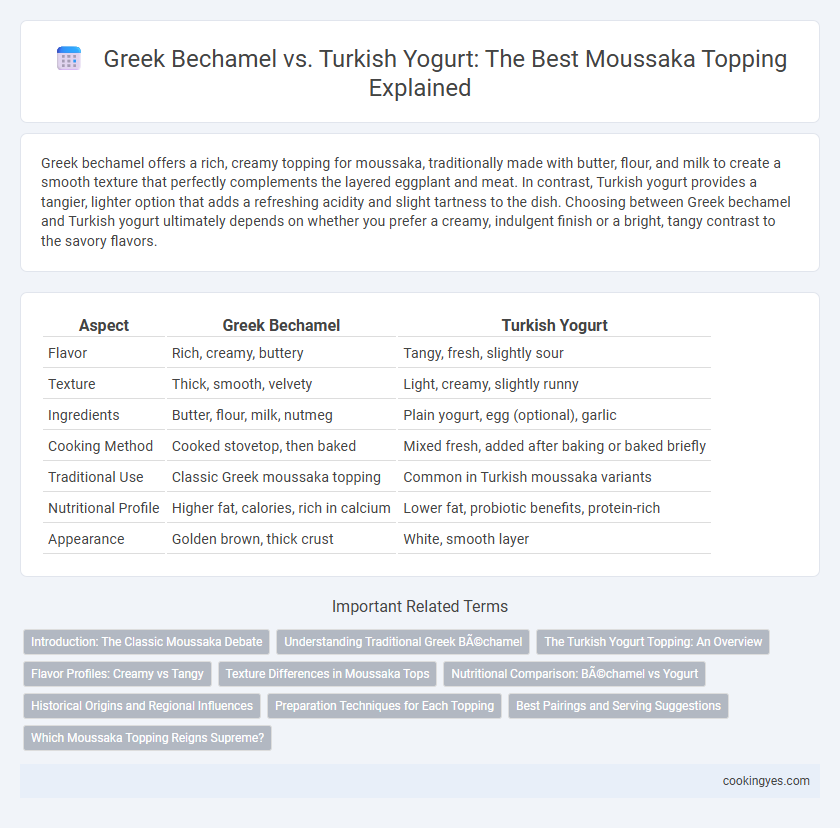Greek bechamel offers a rich, creamy topping for moussaka, traditionally made with butter, flour, and milk to create a smooth texture that perfectly complements the layered eggplant and meat. In contrast, Turkish yogurt provides a tangier, lighter option that adds a refreshing acidity and slight tartness to the dish. Choosing between Greek bechamel and Turkish yogurt ultimately depends on whether you prefer a creamy, indulgent finish or a bright, tangy contrast to the savory flavors.
Table of Comparison
| Aspect | Greek Bechamel | Turkish Yogurt |
|---|---|---|
| Flavor | Rich, creamy, buttery | Tangy, fresh, slightly sour |
| Texture | Thick, smooth, velvety | Light, creamy, slightly runny |
| Ingredients | Butter, flour, milk, nutmeg | Plain yogurt, egg (optional), garlic |
| Cooking Method | Cooked stovetop, then baked | Mixed fresh, added after baking or baked briefly |
| Traditional Use | Classic Greek moussaka topping | Common in Turkish moussaka variants |
| Nutritional Profile | Higher fat, calories, rich in calcium | Lower fat, probiotic benefits, protein-rich |
| Appearance | Golden brown, thick crust | White, smooth layer |
Introduction: The Classic Moussaka Debate
Greek bechamel offers a rich, creamy topping made from butter, flour, and milk, creating a velvety layer that enhances the baked eggplant and meat layers of moussaka. In contrast, Turkish moussaka frequently features a tangy yogurt topping that adds a refreshing acidity and lighter texture to the dish. The choice between bechamel and yogurt significantly influences the overall flavor profile and authenticity of this iconic Mediterranean casserole.
Understanding Traditional Greek Béchamel
Traditional Greek bechamel sauce for moussaka features a creamy base made from butter, flour, and milk, enriched with egg yolks to create a rich, velvety texture that perfectly complements the layered eggplant and meat. Unlike the tangy Turkish yogurt topping, Greek bechamel adds a luxurious, smooth finish that balances the dish's savory flavors without overpowering them. This bechamel is essential in preserving the classic Greek moussaka identity, emphasizing a harmonious blend of creamy and hearty elements.
The Turkish Yogurt Topping: An Overview
The Turkish yogurt topping for moussaka offers a tangy and creamy contrast to the rich layers of eggplant, meat, and spices, enhancing the dish with a lighter, probiotic-rich alternative to traditional Greek bechamel. This yogurt is typically combined with eggs or flour to thicken and create a smooth, slightly tangy custard that complements the savory base without overpowering it. Known for its probiotic benefits and lower fat content, Turkish yogurt topping provides a refreshing and health-conscious variation that maintains the authentic Mediterranean flavor profile.
Flavor Profiles: Creamy vs Tangy
Greek bechamel topping in moussaka offers a rich, creamy texture with a smooth, buttery flavor that complements the layers of eggplant and meat perfectly. Turkish yogurt provides a tangy, slightly acidic contrast that brightens the dish and cuts through the richness of the ingredients. This flavor profile difference creates either a velvety indulgence with bechamel or a refreshing zest with yogurt, catering to diverse culinary preferences.
Texture Differences in Moussaka Tops
Greek bechamel topping in moussaka creates a rich, creamy, and velvety texture that browns to a golden crust, providing a smooth contrast to the hearty layers beneath. Turkish yogurt topping offers a tangy, slightly thinner consistency that yields a lighter, more refreshing finish, often resulting in a less dense and more delicate surface. The choice between bechamel and yogurt directly affects the mouthfeel and visual appeal, with bechamel delivering a luscious, custard-like top, while yogurt imparts a softer, more airy texture.
Nutritional Comparison: Béchamel vs Yogurt
Greek bechamel used in moussaka offers a rich source of calories and fats, primarily from butter, milk, and flour, contributing to a creamy texture and indulgent taste. Turkish yogurt topping provides a lower-calorie and protein-rich alternative, packed with probiotics that aid digestion and enhance gut health. Nutritionally, bechamel is higher in saturated fats and carbohydrates, while yogurt delivers essential vitamins like B12 and calcium with fewer calories and beneficial live cultures.
Historical Origins and Regional Influences
Greek moussaka traditionally features a creamy bechamel sauce topping, reflecting French culinary influence during the 19th century when Western European techniques permeated Greek cuisine. In contrast, Turkish moussaka variants often use yogurt-based toppings, showcasing the Ottoman Empire's regional dairy traditions and emphasizing tangy, fermented flavors integral to Middle Eastern gastronomy. These topping choices underscore distinct historical and cultural exchanges shaping the dish's evolution across Eastern Mediterranean regions.
Preparation Techniques for Each Topping
Greek bechamel topping for moussaka involves whisking butter and flour to create a roux, then gradually adding milk to form a thick, creamy sauce enriched with eggs for a velvety texture. In contrast, the Turkish yogurt topping requires straining full-fat yogurt to remove excess liquid, often seasoned with garlic and herbs, providing a tangy and lighter finish. The bechamel is baked to a golden crust, while the yogurt topping is typically added after cooking, offering distinct texture and flavor profiles in authentic moussaka preparations.
Best Pairings and Serving Suggestions
Greek bechamel sauce offers a rich, creamy texture and subtle nutmeg flavor that perfectly complements the layers of eggplant, ground meat, and tomato in moussaka, creating a classic, indulgent topping. Turkish yogurt provides a tangy and lighter alternative, balancing the dish's richness while adding a refreshing contrast that enhances the spices and herbs in the filling. For serving, dollop yogurt on the side to maintain its coolness or spread bechamel evenly over the moussaka before baking for a golden, velvety crust.
Which Moussaka Topping Reigns Supreme?
Greek bechamel topping delivers a creamy, velvety texture with rich, nutmeg-infused notes that perfectly complement the layered eggplant and meat sauce in traditional Moussaka. Turkish yogurt offers a tangy, lighter alternative that adds a refreshing contrast while maintaining moisture, appealing to those seeking a less heavy finish. Ultimately, Greek bechamel reigns supreme for its luxurious consistency and classic flavor profile that defines authentic Moussaka.
Greek béchamel vs Turkish yogurt for moussaka topping Infographic

 cookingyes.com
cookingyes.com